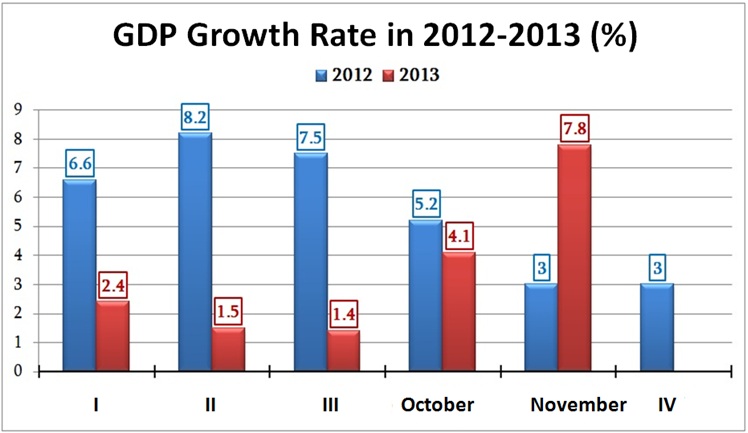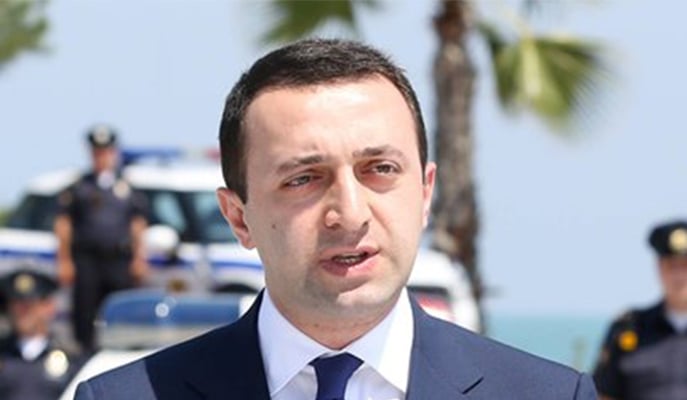which was aired on Rustavi 2 on 27 December 2013, the Prime Minister of Georgia, Irakli Gharibashvili, stated: “[...] in regard to external trade, it took an upturn of 4% in the third quarter. The export increased by 20% which, if I am not mistaken, amounts to a total of USD 2.5 billion. This is a truly unprecedented indicator which was never achieved during the governance of the United National Movement. I will bring an example of the European Union where the volume of our export equalled USD 550-560 million which represents an increase of 65%. Such an indicator, I repeat with pride, has never been witnessed in the country. We brought more than 10 million bottles of wine onto the Russian market. Not only have we received access to the Russian market but the trade turnover saw a threefold growth and, if I am not mistaken, its volume reached USD 116 million. Based upon all the aforementioned I can assert that in the third quarter, the Georgian economy experienced a notable revitalisation. In the month of November the indices of import took an upturn as well which gives a solid ground for positive evaluations not only to our government and our economic team but also, in general, to all experts and international institutions.”
FactChecktook interest in the Prime Minister’s statement and checked its accuracy.
In the course of our inquiry we looked into the publication of the National Statistics Office of Georgia issued on 16 December, the Express Monthly Data on External Trade (November 2013). According to the publication, Georgia’s external merchandise trade amounted to USD 9,681 million in January-November 2013, up 4% from the same period of the previous year. Of this amount, the value of export amounted to USD 2,618 million, surpassing the indicator of the last year’s January-November period (USD 2,179 million) by 20%.
As for the third quarter, in particular, the publication reveals that the value of export equalled USD 782.7 million in the third quarter of 2013 while in the same period of 2012, the export totalled USD 629.9 million. Accordingly, the growth of export in the third quarter of 2013 amounted to 24.3%.
In the third quarter of 2013, the foreign trade turnover totalled USD 2,871.8 million while in 2012 the same indicator equalled USD 2,730.3 million. Therefore, in the third quarter of 2013 the external trade turnover saw a growth of 5.2% which is fairly close to the figure indicated by the Prime Minister. However, owing to the fact that over the first 11 months of 2013 the external trade turnover expanded by 4% and this percentage precisely corresponds to the number named by the Prime Minister, we are led to assume that Irakli Gharibashvili merely confused the time intervals but the overall pathos of his statement, pointing to the optimistic tendencies observable in external trade, is quite accurate.
In November of 2013, the value of import reached USD 778.9 million while in 2012 the same indicator was equal to USD 637.7 million. Subsequently, in the month of November the growth of import amounted to 22.1%.

As for the export to the European Union countries, its value amounted to USD 538.5 million in January-November of 2013. We hold no data on the export indices tothe EU over the period January-November 2012. The comparison of the January-November period of 2013 with the whole year of 2012, however, reveals a 52.5% increase. Naturally, the percentage of increase will be higher than 52.5% if we compare the export value for January-November of 2013 with the same period of 2012 instead of the whole year.
Based upon rough computations, if the total export value to the EU countries amounted to USD 353.1 million in the 12 months of 2012, acalculation of theproportional value would set the figure for 11 months at around USD 323.7 million. Accordingly, the increase is indeed about 65% as indicated by the Prime Minister.

Export value to Russia in January-November 2013 totalled USD 161.3 million which significantly exceeds the same indicator of the previous year.

Apparently, while discussing the newly granted access to the Russian market, the Prime Minister mistakenly uses the term ‘trade turnover’ instead of ‘export’ (Editor’s Note: The term ‘foreign trade turnover’ represents the sum of import and export).
In 2012, the export value to Russia equalled USD 45.8 million while import from Russia amounted to USD473.8 million. Therefore, the trade turnover with Russia totalled USD 518.6 million. In January-November 2013, the export value to Russia was at USD 161.3 million while the import from Russia amounted to USD 518.7 million; therefore, the trade turnover with Russia totalled USD 679 million. Although this is the indicator of solely 11 months, it still shows a significant increase as compared to the figure of all 12 months of 2012 which, naturally, is the result of an increased export as well.
As for the export indicator in particular, as noted above, in the period between January and November of 2013 it amounted to USD 161.3 million which is roughly 3.5 times (USD 45.8 million) more than the indicator of all 12 months of 2012. Based upon rough calculations again, the indicator for the January-November period of 2012 is 3.8 times less than the indicated value of the same period of 2013 – USD 161.3 million.
In line with the statistical data provided by GeoStat, 9,464.4 tons of wine were exported to Russia over the period January-October 2013 (more than 12 million bottles) which in total equalled up to USD 34.1 million.

It is also to be noted that in 2012 the overall export of natural grape wines to different countries of the world amounted to USD 64.9 million while in January-November of 2013 the same indicator rose to USD 114.1 million.
As for the revitalisation of the economy in the third quarter, we thought it reasonable to judge the accuracy of this assertion based upon not only the foreign trade indicators but primarily with respect to the GDP indices.

The data of the third quarter in particular does not offer a solid basis for making definite assumptions about the revitalisation of the economy as the GDP growth rate amounted to an average of 1.4% in the third quarter of 2013 which even falls behind the indicators of the preceding quarters, let alone the same period of the previous year. In October-November, however, the GDP growth rate took an upturn and the indicators for those two months are fairly high at 4.1% and 7.8%, respectively. But these indices, of course, belong to the fourth quarter.
Conclusion
As mentioned above, in January-November of 2013,foreign trade turnover saw an increase of 4% while in the third quarter of 2013 the growth amounted to 5.2%. The increase in export in the first 11 months of 2013 equalled 20% and comprised USD 2,618 million which represents the highest indicator for today. The export to the EU countries totalled USD 538.6 million in the first 11 months of 2013 which notably exceeds the indicator for the whole year of 2012 and also represents the highest indicator recorded so far. A total of 9,464.4 tons of wine were exported to Russia in January-October of 2013 which is equal to more than 12 million bottles. Based upon the data of 11 months, export to Russia amounted to USD 161.3 million which is roughly 3.5 times more than the indicator for all 12 months of 2012.
Despite certain inaccuracies, we conclude that Irakli Gharibashvili’s statement: “[...] in regard to external trade, it took an upturn of 4% in the third quarter. The export increased by 20% which, if I am not mistaken, amounts to a total of USD 2.5 billion. This is a truly unprecedented indicator which was never achieved during the governance of the United National Movement. I will bring an example of the European Union where the volume of our export equalled USD 550-560 million which represents an increase of 65%. Such an indicator, I repeat with pride, has never been witnessed in the country. We brought more than 10 million bottles of wine onto the Russian market. Not only have we received access to the Russian market but the trade turnover saw a threefold growth and, if I am not mistaken, its volume reached USD 116 million. Based upon all the aforementioned I can assert that in the third quarter, the Georgian economy experienced a notable revitalisation. In the month of November the indices of import took an upturn as well which gives a solid ground for positive evaluations not only to our government and our economic team but also, in general, to all experts and international institutions,” is MOSTLY TRUE.





 Prime Minister discussed the growth in external trade.
Prime Minister discussed the growth in external trade.


